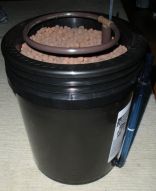Hydroponic gardening doesn’t have to be scary or a laboratory experiment! Consider starting out with either Emily’s Garden and/or the General Hydroponics Drip Ring Kit
The simplest and most common hydroponics system is a DWC (Deep Water Culture) system which consists of a plastic container acting as a reservoir for the nutrient solution with or without an air-pump while the roots hang down into it. You can even make your own from an old bucket and an aquarium water pump in a pinch. Here are some cost-effective methods for starting your own hydro system.
Recirculating Drip Systems options
Recirculating systems are very inexpensive, modular, and very effective. The recirculating system is the same as a DWC (Deep Water Culture) system, with the inclusion of water being pumped over the rooting medium. Support your plants by giving the roots something to grab onto and hydrate as needed. I recommend starting seeds with coco-coir (pronounced coyer) and then expanding into clay pellets (also known as LECA (Lightweight Expanded Clay Aggregate), or by the common brand name “Hydroton”) as the medium for containing your plants’ roots.
The best systems use a single air pump to both aerate the nutrient solution and pump the water up over the rooting medium. Let’s take a look at our options…
Drip System Options

I’ve distilled the recirculating drip system for hydroponics down into the following options:
Start with one module completely off-the-shelf:
General Hydroponics Complete Single WaterFarm Kit
or dive immediately into a complete system that is completely off-the-shelf:
General Hydroponics Complete 8-pack WaterFarm Kit
OR make your own!
DIY Drip System, partially off-the-shelf:
- 3 or 5 gallon bucket ( new, or thoroughly cleaned )
- with lid ( see cutting holes in the lid ) or hydroponics bucket lid basket (various sizes)
- with lid ( cut holes in the lid ) or hydroponics bucket lid basket (various sizes)
- aquarium air-pump ( 1/4″ vinyl tubing comes with their kit: )
- General Hydroponics Farm Kit
STEPS
- Prepare the bucket by removing the handle. You should not need to use any tools to remove the handle. Look under the lip of the bucket’s handle to see how it is attached and which way to twist it around until it pops out.
- Lay the bucket on its side lengthwise. Using a metal ruler (or eyeball it if you’re that good), line up a hole where the handle was inserted with the bottom of the bucket. Measuring from the bottom of the bucket, mark 1″ up.
- Drill the drain hole: Use one hand to steady the bucket, while you use a 13/16″ spade bit or Forstner bit in your drill, slowly drill through the plastic while taking care to maintain balance of the bit’s penetration through the material.
- Remove any remaining debris from the freshly cut hole; you may need to clean it up with a reaming tool or a utility knife.
- Insert the grommet by placing one hand inside the bucket to stop the grommet from slipping all the way through and apply pressure pushing the grommet pointed side into the hole. Ensure that the grommet is fully seated in place.
- Install the blue 1/2″ vinyl tubing and insert the elbow by supporting the grommet from the inside of the bucket, while you push the fitting through from the outside.
- Click in the drain line clip using a wire loom clip (included in the FarmKit) or a small zip tie through the bucket’s handle hole and either another zip tie or a tube clip to support the drain line.
- Do not over tighten the zip tie, you should be able to pull the tubing out and back in place.
- If using a hydroponics basket like the one pictured, you’ll need to take a snip out of one of the outer bottom strips.
- Slide the brown recirculation tubing through the cut-slit about half-way.
- Drip-ring mounts on top and you just need to hook-up the air-pump.
“Upcycle” plastic containers
Plastic lidded storage totes are typically used to make DIY DWC (Deep Water Culture). There many tutorials on this topic, so I won’t replicate them here. My latest version uses an empty plastic kitty litter container. Reusing plastic containers to make simple hydroponics systems is by far the least expensive way to get growing. When reusing containers consider that there is a possibility that the plastic will break down over time and may leach into the system. Also, be judicious about which types of containers you choose to reuse. I feel that the kitty litter container is safe enough after being thoroughly cleaned, but obviously any container that once held anything toxic should be recycled appropriately.
Next up? How to Grow Happy Plants







Leave a comment